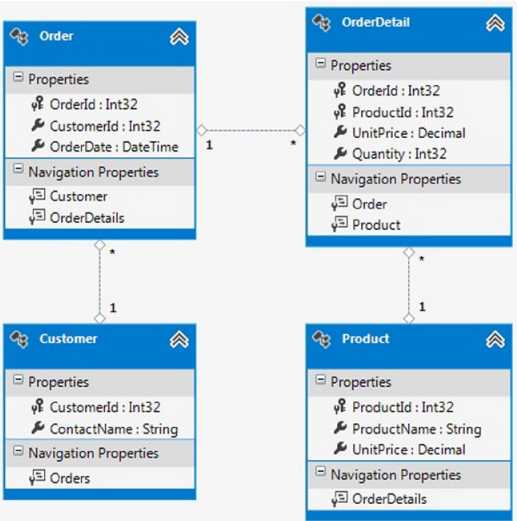标签:
对象不应该知道如何保存它们,加载它们或者过滤它们。这是软件开发中熟悉的口头禅,特别是在领域驱动设计中。这是一个聪明的做法,如果对象和持久化绑得太紧,以至于不能对领域对象进行单元测试、重构和复用。在ObjectContext上下对象中,实体框架为模型实体生成的类,高度依赖实体框架管道(Plumbing)。对于一此开发人员来说,这些类对持久化机制知道得太多了。而且,它们与特定的模型和映射关联太密切。幸好,我们还有另一个选项。
实体框架还支持使用你自己创建的类来作为模型中的实体。术语叫做“普通公共运行时对象”(Plain Old CLR Object),通常被简单地叫做POCO,这并不意味着你的类普通而老掉牙。它仅仅是说,它不包含特定框架的引用,不需要来至第三方的代码,不实现任何第三方的专用接口,并且,它不需要别的任何程序集或者命名空间。你可以实现自己的领域对象,你会看到通过自定义的ObjectContext上下对象使它们适合模型。也就是说,凭借实体框架强大的能力,你可以选择任何架构模式。你同样也能使用DbContext为你产生POCO类。
本章涵盖了多个关于POCO的小节。第一节展示POCO最基本的用法,剩下的小节集中在,实体的加载和实体框架使用对象状态保持同步。
本章故意手工编写了大量的POCO类,是为了演示如何运用POCO。如果使用来至微软ADO.NET开发团队的T4模板,这些工作都将不复存在。
问题
你想在你的项目中使用POCO。
解决方案
假设你有如图8-1所示的数据模型。

图8-1. 一个关于客户和它的订单的数据库模型
为了使用POCO类创建基于图8-1所示的数据库模型的实体框架模型,请按下面的步骤进行操作:
1、右键你的项目,选择Add(增加) ?New Item(新建项);
2、选择Visual C#条目下的Data(数据)模板下的ADO.NET Entity Data Model(ADO.NET实体数据模型);
3、选择Generate from database 从一个已存在的数据库创建模型;
4、选择表order,OrderDetail,Customer和Product,单击下一步。在生成的模型中,实体Product有一个导航属性OrderDetails,它是关联产品的订单明细。在这里它不是必要的,因此将其删除(译注:实际上,没有删除)。完成后的模型如图8-2所示。

图8-2. 客户订单的模型
5、我们使用生成的类作为的我们实体,默认情况下,实体框架6生成POCO实体类。 因此,所有的数据库访问代码都在一个单独的类中,实体被生成为普通的类。还可以在实体框架生成实体类之前关闭模型的代码生成功能,然后手工创建相同的实体类。 在这个版本中,代码生成策略已经被设置成None.代码清单8-1展示了我们模型中的类。
代码清单8-1. 我们模型的POCO类
1 public partial class Customer 2 { 3 public Customer() 4 { 5 this.Orders = new HashSet<Order>(); 6 } 7 8 public int CustomerId { get; set; } 9 public string ContactName { get; set; } 10 11 public virtual ICollection<Order> Orders { get; set; } 12 } 13 14 public partial class Order 15 { 16 public Order() 17 { 18 this.OrderDetails = new HashSet<OrderDetail>(); 19 } 20 21 public int OrderId { get; set; } 22 public int CustomerId { get; set; } 23 public System.DateTime OrderDate { get; set; } 24 25 public virtual Customer Customer { get; set; } 26 public virtual ICollection<OrderDetail> OrderDetails { get; set; } 27 } 28 29 public partial class OrderDetail 30 { 31 public int OrderId { get; set; } 32 public int ProductId { get; set; } 33 public decimal UnitPrice { get; set; } 34 public int Quantity { get; set; } 35 36 public virtual Order Order { get; set; } 37 public virtual Product Product { get; set; } 38 } 39 public partial class Product 40 { 41 public Product() 42 { 43 this.OrderDetails = new HashSet<OrderDetail>(); 44 } 45 46 public int ProductId { get; set; } 47 public string ProductName { get; set; } 48 public decimal UnitPrice { get; set; } 49 50 public virtual ICollection<OrderDetail> OrderDetails { get; set; } 51 }
注意,没有Product到OrdeDetail的关联,因为我们在设计器中移除了导航属性(译注:实际上,没有移除)
6、为了使用POCO类,实体框架生成了DbContext的派生类。这个类将我们模型中的每个实体公布成ObjectSet<T>类型。 代码清章8-2演示了,这个类的定义。
代码清单8-2. 生成模型时创建的DbContext派生类
1 public partial class EFRecipesEntities : DbContext 2 { 3 public EFRecipesEntities() 4 : base("name=EFRecipesEntities") 5 { 6 } 7 8 protected override void OnModelCreating(DbModelBuilder modelBuilder) 9 { 10 throw new UnintentionalCodeFirstException(); 11 } 12 13 public DbSet<Customer> Customers { get; set; } 14 public DbSet<Order> Orders { get; set; } 15 public DbSet<OrderDetail> OrderDetails { get; set; } 16 public DbSet<Product> Products { get; set; } 17 }
这样就完成了使用生成POCO类的模型,代码清单8-3演示了从模型中插入和获取数据
代码清单8-3. 使用POCO类
1 class Program 2 { 3 static void Main(string[] args) 4 { 5 RunExample(); 6 } 7 8 static void RunExample() 9 { 10 using (var context = new EFRecipesEntities()) 11 { 12 var tea = new Product { ProductName = "Green Tea", UnitPrice = 1.09M }; 13 var coffee = new Product 14 { 15 ProductName = "Colombian Coffee", 16 UnitPrice = 2.15M 17 }; 18 var customer = new Customer { ContactName = "Karen Marlowe" }; 19 var order1 = new Order { OrderDate = DateTime.Parse("10/06/13") }; 20 order1.OrderDetails.Add(new OrderDetail 21 { 22 Product = tea, 23 Quantity = 4, 24 UnitPrice = 1.00M 25 }); 26 order1.OrderDetails.Add(new OrderDetail 27 { 28 Product = coffee, 29 Quantity = 3, 30 UnitPrice = 2.15M 31 }); 32 customer.Orders.Add(order1); 33 context.Customers.Add(customer); 34 context.SaveChanges(); 35 } 36 37 using (var context = new EFRecipesEntities()) 38 { 39 var query = context.Customers.Include("Orders.OrderDetails.Product"); 40 foreach (var customer in query) 41 { 42 Console.WriteLine("Orders for {0}", customer.ContactName); 43 foreach (var order in customer.Orders) 44 { 45 Console.WriteLine("--Order Date: {0}--", 46 order.OrderDate.ToShortDateString()); 47 foreach (var detail in order.OrderDetails) 48 { 49 Console.WriteLine( 50 "\t{0}, {1} units at {2} each, unit discount: {3}", 51 detail.Product.ProductName, 52 detail.Quantity.ToString(), 53 detail.UnitPrice.ToString("C"), 54 (detail.Product.UnitPrice - detail.UnitPrice).ToString("C")); 55 } 56 } 57 } 58 } 59 Console.WriteLine("Enter input to exit:"); 60 string line = Console.ReadLine(); 61 if (line == "exit") 62 { 63 return; 64 }; 65 } 66 }
代码清单8-3的输出如下:
Orders for Karen Marlowe --Order Date: 4/19/2010-- Green Tea, 4 units at $1.00 each, unit discount: $0.09 Colombian Coffee, 3 units at $2.15 each, unit discount: $0.00
原理
生成POCO类,是当前版本实体框架的默认特性。代码生成策略的属性值已经被设置为None。上下文对象也是被单独生成。所以POCO类中已经没有了数据访问代码。
如果与模型中实体对应的所有类已经被创建,它们简单,洁净。这样的话就,没有代码生成,没有上下文被生成。为了实现适合我们模型和实体的上下文对象,派生至DbContext的一个新类在数据模型生成时就被创建了。这个类还提供了对应每个实体的,类型为DbSet<T>的属性。 默认情况下,我们的上下文对象EFRecipesEntities,已经包含了能连接数据库的构造函数代码。
实体框架交流QQ群: 458326058,欢迎有兴趣的朋友加入一起交流
谢谢大家的持续关注,我的博客地址:http://www.cnblogs.com/VolcanoCloud/
《Entity Framework 6 Recipes》中文翻译系列 (42) ------ 第八章 POCO之使用POCO
标签:
原文地址:http://www.cnblogs.com/VolcanoCloud/p/4545314.html